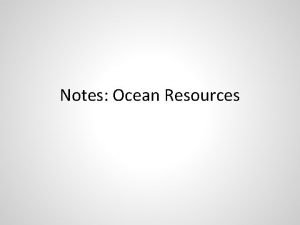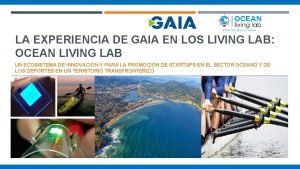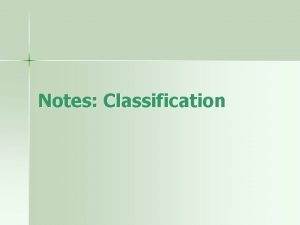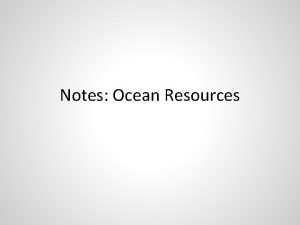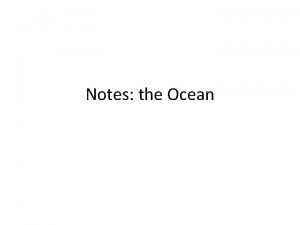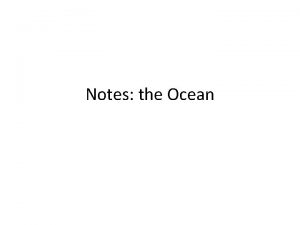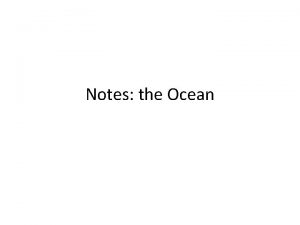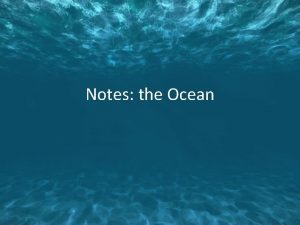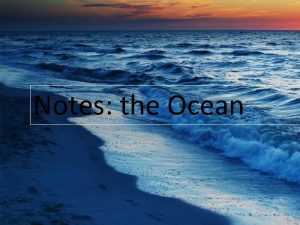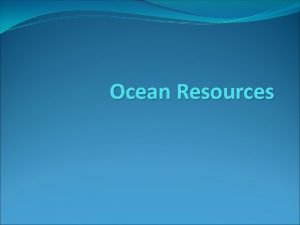Notes Ocean Resources What are living resources Ocean








- Slides: 8

Notes: Ocean Resources

What are living resources? • Ocean animals are a food source. • Phytoplankton produce a lot of Earth’s oxygen. • Some ocean organisms are being researched for properties that might cure disease. • Seafood & algae – Huge food source – Algae is used to make some food (cheese, ice cream) and other products (shaving cream, toothpaste, pesticides). – Most seafood caught by big fishing nets • Fisheries: areas where a lot of commercial fishing takes place – Fisheries provide about 16% of the world’s protein

How do humans have a negative impact on the ocean? • Overfishing and by-catch (by-kill) – Overfishing: catching fish faster than they can reproduce • Major threat to ocean environments • Ex: Cod—once very common in Atlantic ocean, now there are few left • Fisheries—main fishing areas of the ocean—most are overfished – By-catch (by-kill) • Nets catch more than they should • Portion of animals caught & thrown back (dead or alive)— sometimes more than what the net is meant to catch—nets catch dolphins and sea turtles too. • New nets reduce by-catch—still throw away about 30% of what they catch. • Salt-water aquaculture (raise fish, oysters, shrimp, etc) → can cause lots of waste, often clear mangrove forests to make room for the farms.

Human impact (cont. ) • Pollution – Every part of the ocean is polluted. – Solid waste (plastic bottles, needles, etc. ), chemicals, mercury, lead – Waste, sewage, & fertilizers have caused dead zones in the ocean (no plants or animals) – Most pollution is run-off from land (44%) – Preventing ocean pollution • Laws, properly disposing of chemicals – Ocean pollution is a global problem! • Currents carry water everywhere. • Oceans are all connected • 1944 Law of the Sea—manage resources, enforce pollution laws, conserve ocean

What is dredging? • Dredging is using a machine attached to a ship that pulls sand up from the ocean floor and either moves it, or removes it to use on land. • Dredging of any kind pulls up the ocean floor (and can pull organisms with it!), causing a cloud of sediment to rise in the water, blocking sunlight for plants and phytoplankton. • Dredging can also introduce heavy metals into the ocean food chain (pull metals from the bottom).

What are some nonliving resources in the ocean? • Desalination used in some countries. • Energy resources • Minerals & rocks – Wash into the ocean from land—most found close to shore – Nodules: lumps of minerals on ocean floor – Iron and cobalt (used to make steel), gold, lead, tin, diamonds, etc. – Sand & gravel used in building materials – Too expensive to remove them currently.

How do we drill for oil in the ocean? • First, an oil well must be found in the ocean. Geologists locate potential wells beneath the ocean floor through surveys using special equipment. – When a potential well is found, government permission must be granted for exploratory drilling to see if the oil is actually there and if we can get it out. • If oil or gas is found, a production well is drilled, and an oil rig is built. An average well lasts 10 -20 years. • Initially the pressure from the reservoir of oil is enough to pump it out, but over time, the pressure decreases, and other techniques must be used to help pump it. • Crude oil obtained from a well is refined at oil refineries onshore. • Environmental concerns: – The rigs impact living creatures, making noise, blocking their path, polluting the water. – Potential oil spills

How does tourism affect the ocean? • Tourism is the fastest growing division of the world economy and is responsible for over 200 million jobs around the world. • Tourism often has a negative impact on coastal and ocean ecosystems: – Development of coastal habitats (new buildings, like hotels, malls, etc. ) – Garbage and sewage generated by visitors—usually produce more than locals • If this is dumped into the ocean, it can lead to eutrophication (an overgrowth of algae), which can harm other organisms. – Tourists can bring new diseases and lead to epidemics • Ecotourism is a new trend that favors low impact tourism and creates a respect for local cultures and ecosystems.

